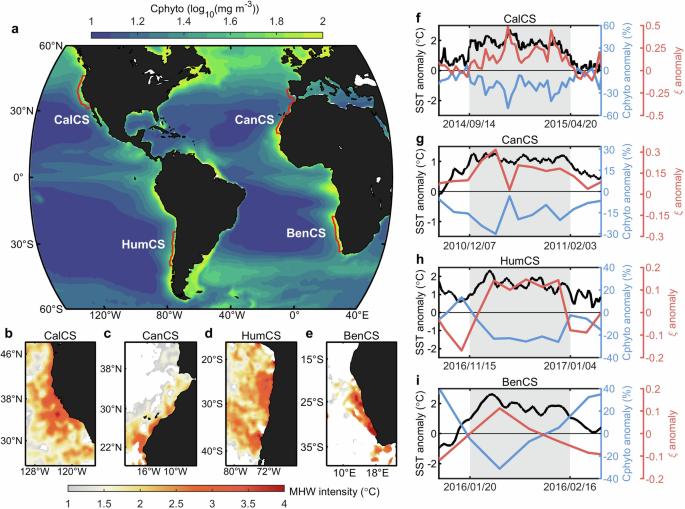Reduced and smaller phytoplankton during marine heatwaves in eastern boundary upwelling systems
IF 8.1
1区 地球科学
Q1 ENVIRONMENTAL SCIENCES
引用次数: 0
Abstract
Marine heatwaves have attracted great attention for their devastating impacts on marine organisms. However, the influence of marine heatwaves on phytoplankton community structure, a key aspect of pelagic ecosystems, remains elusive, especially in the biologically productive eastern boundary upwelling systems. Here, using a combination of multi-satellite observations and model outputs, we discover that phytoplankton in these upwelling systems exhibit not only a marked reduction in biomass (~50%), but also a significant shift toward smaller species in community structures during marine heatwaves, featuring a substantially increased/decreased dominance in picophytoplankton/microphytoplankton. This change in community structure is positively related to the intensity and duration of marine heatwaves, and is likely a result of community competition under reduced nutrient supply due to weakened coastal upwelling associated with poleward wind anomalies. These findings invite us to rethink the dominance of phytoplankton in the eastern boundary upwelling systems under extreme conditions, and may have important implications for local fisheries and carbon cycle under the ongoing warming. Longer and more intense marine heatwaves are associated with a dominance of smaller plankton species and lower overall biomass, according to an analysis of ocean color satellite data and distribution modeling.

东部边界上升流系统中海洋热浪期间浮游植物减少且体积变小
海洋热浪因其对海洋生物的破坏性影响而备受关注。然而,海洋热浪对浮游植物群落结构(浮游生态系统的一个关键方面)的影响仍然难以捉摸,尤其是在生物生产力极高的东部边界上升流系统中。在这里,我们综合利用多卫星观测数据和模型输出结果,发现在海洋热浪期间,这些上升流系统中的浮游植物不仅生物量显著减少(约 50%),而且群落结构也明显向小型物种转变,其特点是皮浮游植物/微浮游植物的优势显著增加/减少。群落结构的这种变化与海洋热浪的强度和持续时间呈正相关,很可能是由于极向风异常导致沿岸上升流减弱,营养物质供应减少,群落竞争加剧的结果。这些发现促使我们重新思考在极端条件下浮游植物在东部边界上升流系统中的主导地位,并可能对正在变暖的当地渔业和碳循环产生重要影响。根据对海洋颜色卫星数据和分布模型的分析,持续时间更长、强度更大的海洋热浪与小型浮游生物物种占优势和总体生物量较低有关。
本文章由计算机程序翻译,如有差异,请以英文原文为准。
求助全文
约1分钟内获得全文
求助全文
来源期刊

Communications Earth & Environment
Earth and Planetary Sciences-General Earth and Planetary Sciences
CiteScore
8.60
自引率
2.50%
发文量
269
审稿时长
26 weeks
期刊介绍:
Communications Earth & Environment is an open access journal from Nature Portfolio publishing high-quality research, reviews and commentary in all areas of the Earth, environmental and planetary sciences. Research papers published by the journal represent significant advances that bring new insight to a specialized area in Earth science, planetary science or environmental science.
Communications Earth & Environment has a 2-year impact factor of 7.9 (2022 Journal Citation Reports®). Articles published in the journal in 2022 were downloaded 1,412,858 times. Median time from submission to the first editorial decision is 8 days.
 求助内容:
求助内容: 应助结果提醒方式:
应助结果提醒方式:


